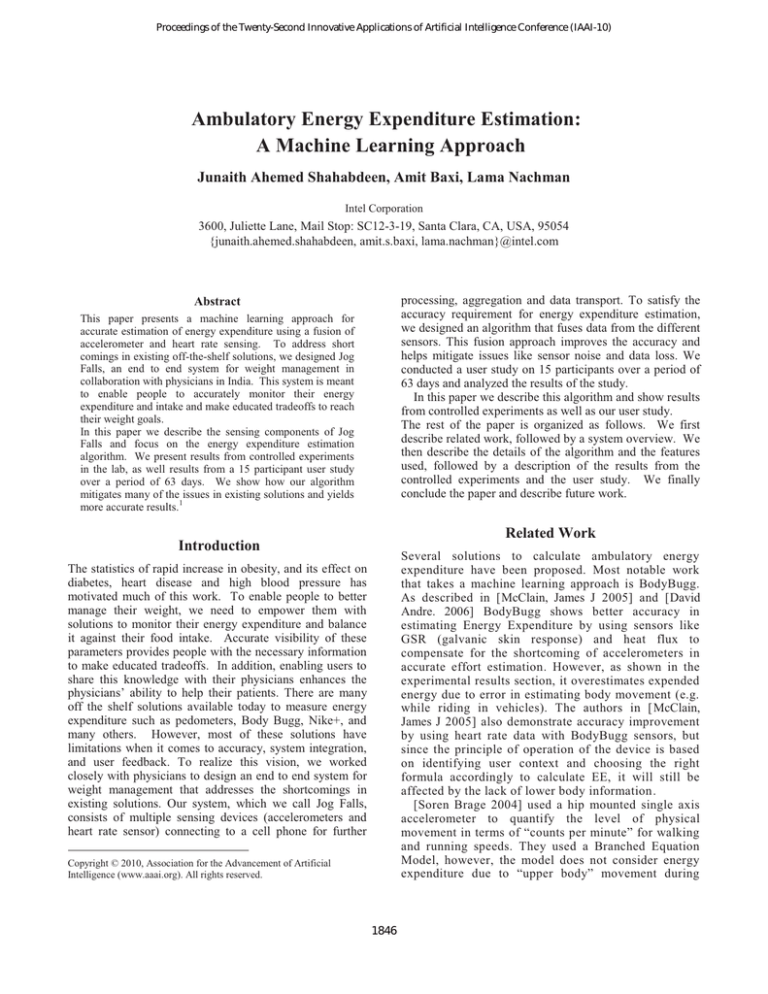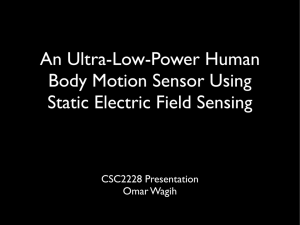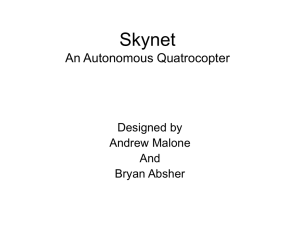
Proceedings of the Twenty-Second Innovative Applications of Artificial Intelligence Conference (IAAI-10)
Ambulatory Energy Expenditure Estimation:
A Machine Learning Approach
Junaith Ahemed Shahabdeen, Amit Baxi, Lama Nachman
Intel Corporation
3600, Juliette Lane, Mail Stop: SC12-3-19, Santa Clara, CA, USA, 95054
{junaith.ahemed.shahabdeen, amit.s.baxi, lama.nachman}@intel.com
processing, aggregation and data transport. To satisfy the
accuracy requirement for energy expenditure estimation,
we designed an algorithm that fuses data from the different
sensors. This fusion approach improves the accuracy and
helps mitigate issues like sensor noise and data loss. We
conducted a user study on 15 participants over a period of
63 days and analyzed the results of the study.
In this paper we describe this algorithm and show results
from controlled experiments as well as our user study.
The rest of the paper is organized as follows. We first
describe related work, followed by a system overview. We
then describe the details of the algorithm and the features
used, followed by a description of the results from the
controlled experiments and the user study. We finally
conclude the paper and describe future work.
Abstract
This paper presents a machine learning approach for
accurate estimation of energy expenditure using a fusion of
accelerometer and heart rate sensing. To address short
comings in existing off-the-shelf solutions, we designed Jog
Falls, an end to end system for weight management in
collaboration with physicians in India. This system is meant
to enable people to accurately monitor their energy
expenditure and intake and make educated tradeoffs to reach
their weight goals.
In this paper we describe the sensing components of Jog
Falls and focus on the energy expenditure estimation
algorithm. We present results from controlled experiments
in the lab, as well results from a 15 participant user study
over a period of 63 days. We show how our algorithm
mitigates many of the issues in existing solutions and yields
more accurate results.1
Related Work
Introduction
Several solutions to calculate ambulatory energy
expenditure have been proposed. Most notable work
that takes a machine learning approach is BodyBugg.
As described in [McClain, James J 2005] and [David
Andre. 2006] BodyBugg shows better accuracy in
estimating Energy Expenditure by using sensors like
GSR (galvanic skin response) and heat flux to
compensate for the shortcoming of accelerometers in
accurate effort estimation. However, as shown in the
experimental results section, it overestimates expended
energy due to error in estimating body movement (e.g.
while riding in vehicles). The authors in [McClain,
James J 2005] also demonstrate accuracy improvement
by using heart rate data with BodyBugg sensors, but
since the principle of operation of the device is based
on identifying user context and choosing the right
formula accordingly to calculate EE, it will still be
affected by the lack of lower body information.
[Soren Brage 2004] used a hip mounted single axis
accelerometer to quantify the level of physical
movement in terms of “counts per minute” for walking
and running speeds. They used a Branched Equation
Model, however, the model does not consider energy
expenditure due to “upper body” movement during
The statistics of rapid increase in obesity, and its effect on
diabetes, heart disease and high blood pressure has
motivated much of this work. To enable people to better
manage their weight, we need to empower them with
solutions to monitor their energy expenditure and balance
it against their food intake. Accurate visibility of these
parameters provides people with the necessary information
to make educated tradeoffs. In addition, enabling users to
share this knowledge with their physicians enhances the
physicians’ ability to help their patients. There are many
off the shelf solutions available today to measure energy
expenditure such as pedometers, Body Bugg, Nike+, and
many others. However, most of these solutions have
limitations when it comes to accuracy, system integration,
and user feedback. To realize this vision, we worked
closely with physicians to design an end to end system for
weight management that addresses the shortcomings in
existing solutions. Our system, which we call Jog Falls,
consists of multiple sensing devices (accelerometers and
heart rate sensor) connecting to a cell phone for further
Copyright © 2010, Association for the Advancement of Artificial
Intelligence (www.aaai.org). All rights reserved.
1846
values over a minute and passes it to the Data Fusion
algorithm. All the computed values are stored on a
flash card and used for post-analysis.
sedentary activities (like working on PC, bending,
arranging drawers, cooking, ironing etc) hence leading
to underestimation of energy expenditure. Another
shortcoming of their solution is that if one of the
sensors stops providing data, the system will not
output any energy expenditure. We address both of
these limitations in our solution. [K Rennie 2000]
used a single integrated chest mounted movement and
HR sensor. They address the effect of emotion on HR
and the quantification of excretion, however, the
algorithm will be affected by the lack of lower body
movement data.
Results from [Daniel Olgun 2006] and [Ling Bao
2004] prove that a combination of accelerometer data
from upper and lower body always yields higher
accuracy in identifying user activities, compared to a
single accelerometer. The errors are mainly due to the
misinterpretations of the movement noise caused in the
accelerometer. The same conclusion could be extended
to the technologies described in [Soren Brage 2004][K
Rennie 2000][ McClain, James J 2005] and [David
Andre.2006], which use a single accelerometer either
on the upper or lower body for EE calculation.
Individual Calibration
Energy requirement of any activity can also be quantified
in terms of METs. Each activity has a specific MET value,
proportional to the required effort. Multiplying MET by
the Weight (W) of the individual in Kg gives the EE in
kcal per hour. MET values published in the Compendium
of Physical Activities [ Ainsworth 2000] were used.
Heart Rate Calibration
Since both EE and HR are proportional to Oxygen Uptake
(VO2), HR can be used to estimate EE. However, as HR at
particular activity intensity depends on the fitness level of
the individual, HR needs to be calibrated for each
individual to estimate EE. In our calibration procedure,
subjects walked for 3 minutes each, at different walking
speeds, during which their HR and MET equivalent to the
walking speed were noted to build an individualized HR
v/s MET calibration table. Before the start of the
calibration procedure, subject’s Resting Heart Rate (RHR)
was also noted.
System Overview
Our Energy Expenditure estimation system contains the
following components:
Accelerometer Calibration
The CA was used to quantify the activity intensity of lowintensity, non-walking activities which involve the upper
body movements. Signals from 3-axis of the CA, were
combined and averaged to form a composite signal,
proportional to the upper body movement. BodyBugg has
been shown to be accurate at estimating the resting energy
expenditure [Malavolti 2007] [Fruin 2003], it was also
verified in our Controlled Calorimeter experiment. Hence,
the average magnitude of this composite signal was
calibrated in the range of 0 to 3 METs while performing
different sedentary activities (like sitting and working with
hands, bending, cleaning, ironing, arranging drawers),
using BodyBugg as reference. We refer to the METs
estimated by the CA as CA_MET. Performing any
activities with intensity greater than or equal to slow walk
will result in a CA_MET value exceeding 3.
Chest Sensor
The Chest Sensor (CS), designed in-house, is
comprised of a wearable ECG Heart Rate (HR)
monitor with an integrated 3-axis accelerometer
sensor. The CS uses the integrated Chest
Accelerometer (CA) to estimate the intensity of upper
body movement (such as bending, turning, movement
of hands) in terms of Metabolic Equivalents (METs),
which we refer to as CA_MET. The CS sends
computed HR and the CA_MET values to a cell phone,
wirelessly over Bluetooth, every 5 seconds.
Hip Sensor
The Multi-sensor Platform [MSP], which also has an
integrated 3-axis accelerometer, is used as Hip Sensor
(HS). The signals from the Hip Accelerometer (HA)
are classified using machine learning algorithms to
identify user activity (sitting, walking, running etc)
and walking speed. The HS sends the walking speed
(S) and activity information to the cell phone,
wirelessly over Bluetooth, every 5 seconds.
Theory of Operation of Fusion Algorithm
The features extracted from hip, chest accelerometer
and heart rate are used to determine the best possible
sensor to calculate Energy Expenditure (EE) for a
given context. This enables a comprehensive analysis
of user’s physical state and amount of exertion in an
activity. In addition it allows mitigating failures
caused by missing data or sensor failure. Some of the
cases addressed by our algorithm that differentiate our
solution are listed below.
Data Aggregator
The Cell phone runs the Data Fusion algorithm which
fuses data from HR, CS and HS to estimate the EE
every minute. The cell phone continuously aggregates
computed values from the CS and the HS, averages the
1847
Psychological & emotional factors influence heart
rate leading to higher estimation of EE. The Fusion
algorithm uses heart rate trending in conjunction
with lack of movement in the upper and lower body
to identify the emotion effect on heat rate and
calculate EE based on the accelerometer.
During the recovery phase of an exercise, heart
rate tends to overestimate the expended energy,
while the accelerometer tends to underestimate it.
The fusion algorithm adopts a switching technique
that minimizes the error by using heart rate during
the initial ramp down and switching to accelerometer
after the ramp down of the heart rate.
Vibrations in a moving vehicle could influence the
accelerometer leading to higher estimation of EE.
The fusion algorithm is designed to identify the
condition and switch to the heart rate sensor.
Accelerometer can’t estimate effort accurately
(e.g. tell the difference between walking or walking
while carrying a heavy load). The fusion algorithm
can identify this context and use heart rate which
will be more representative of the effort.
Choosing a single best sensor from all available
sensors allows the fusion algorithm to gracefully
degrade during sensor failures, and continue operation
by using the information from the existing sensors.
Alternative approach is to estimate a combined MET
value from the sensors. We took the former approach
due to our familiarity with context recognition and the
fact that many of the components were already
developed.
Figure 1 BayesNet for sensor validity
And
BayesNet Model
The local probabilities favor
compared to the other queries and thus influencing the
decision to choose Hear Rate sensor.
Similarly, in case of vehicle noise, the local probabilities
look as follows
We used Bayesian Network to infer the validity of the
sensors. The network structure learnt using data from our
controlled experiment is shown in Figure 1. The decision
variables like “HR Validity”, “Upper Body Accel Validity”
and “Lower Body Accel Validity” are binary variables,
representing valid and invalid states with equal priors. The
feature variables consist of states representing discrete
value ranges learnt from the training data. Three different
queries
,
,
and
will be performed on the
network after extracting features from the sensor data to
calculate conditional probability of validity of each sensor.
The query that returns the highest probability is chosen as
the preferred sensor.
For example, in the case of a weight lifting, the upper
body accelerometer will tend to record higher movement
than the lower body and at the same time heart rate of the
subject will be elevated well above normal. The above
evidence affect the individual probability of the nodes as
follows,
Thus reducing the chances of picking the noisy
accelerometers for calculating EE. It is worth observing the
indirect influences in the graph. For example, the “Upper
Body Accel MET” influences “HR Validity” and “Lower
Body Accel Validity” when “Upper Body Accel Validity”
is not observed. Similarly the HR Features affect the
“Upper Body Accel Validity” through the “Lower Body
Speed”.
It is evident from examples above that features from all
the sensors will either directly or indirectly influence all
three of the decision nodes, and thus reinforcing each other
in choosing the right sensor for a given context.
1848
(2)
Sensor Features
Similarly,
Delta Heart Rate: This feature represents the difference
between the mean heart rate of a given 1 minute window
and the resting heart rate of the subject. The delta value is
split in to 3 discrete ranges which form the elements of the
random variable set.
Heart Rate Forward Difference: This feature represents
the mean value of forward difference of heart rate in a
given 1 minute window. The feature provides the trending
of the HR data in a given window. For example, was the
HR consistently reducing, increasing or stayed almost flat.
Lower Body Speed: This feature represents the speed of
movement of the lower body using hip accelerometer. It
can capture walking and running speed in MPH.
Upper Body MET: This feature provides a metabolic
equivalent of the movement captured in the upper body
accelerometer.
Mean Heart Rate: This feature provides the mean heart
rate for any given minute.
Heart Rate Mean difference: This feature represents the
difference in mean heart rate across successive window. It
provides information about the trend of heart rate across
windows.
(3)
Applying 2 and 3 in 1
(4)
Thus the CPD associated with each variable given its
parents can be used to calculate the joint probability and
ultimately the conditional probability of the class variable.
Similar queries can be formed for “Lower Body
Accelerometer Validity”, and “Upper Body Accelerometer
Validity”.
In case of missing data from one of the sensors, the
algorithm allows to integrate over missing variables in the
graph, facilitating a smooth operation. For example, let
be the evidence from lower body accelerometer and
represent the evidence set from rest of the sensors. In the
case of missing lower body accelerometer data, equation
(4) can be written as follows,
P( HR
v | EMSP , E )
EMSP
P(eMSP , E | HR
( P ( HR
Model Learning
EMSP
v, eMSP , E ) P( HR
v)
(5)
nv, eMSP , E ))
We designed the energy expenditure calculation to be
performed every minute to help average erroneous input
from the sensors that could lead to wrong sensor choice.
A supervised learning approach was adopted to create the
model. The training examples are generated by using data
from the lab experiment described in the “Calorimeter
Experiment” section below. We used WEKA [Witten 1999]
for learning the structures and parameters of the BayesNet.
The structure of the BayesNet and the CPT (Conditional
Probability Table) for the random variables are learnt using
K2 greedy search algorithm with Bayes estimator. We
compared the inference results by learning network with
three and four maximum parents per node and found that
adding an additional parent to the variable did improve the
inference and hence decided to go with four parents.
Experiment and Results
This Section describes the experiments performed for
training and validating the system, together with the results
from the deployment.
Calorimeter Experiment
A lab experiment was conducted in the Human
Performance Laboratory of Oregon Health Science
University. The experiment aimed at understanding the
limitations of the sensor data like Heart rate, lower and
upper body acceleration in comparison to Calorimeter
which is considered as one of the golden standards for
calculating EE. The calorimeter (Figure 4) is a device that
measures the oxygen uptake and requires inserting a large
fixture into the mouth and plugging the nose to ensure that
oxygen flow is fully captured and measured through the
device. It is uncomfortable to wear and restricts the
person’s movement quite a bit, so we needed to give
frequent breaks to subjects while performing the
experiment. As a result, it is not an option to use the
calorimeter in real settings, but it is a great tool for
performing controlled experiments and calibrating other
equipment.
Four subjects wearing a hip mount accelerometer,
BodyBugg
(arm
mounted
with
multiple
Inference and EE Calculation
The BayesNet consists of 3 decision nodes, each attempt to
answer the validity question of one of the sensors. For
example, if the question we want to answer is P(HR
Validity) we will observe the nodes, “Delta HR”, “Lower
Body Speed”, “Upper Body MET” and “HR Forward
Difference”.
The probability of decision variable is calculated using
Baye’s rule, given all the features from various sensors.
Let HR represent the class variable for “Heart Rate
Validity”. Let E represent all the other random variables
used as evidence.
Let HR = {v, nv}, be the states representing HR Valid
and HR not valid.
v)P( HR
(1)
The joint probability of the BayesNet using chain rule
can be written as
1849
Figure 3 Compare MET values of Heart rate and
accelerometer with calorimeter
Figure 4 One of the authors in Calorimeter setup
sensors)[BodyBugg], Polar HR monitor [Polar] were
connected to the Calorimeter. Required parameters like,
lower / upper body movement, heart rate, and EE from the
calorimeter were logged. Subjects were asked to perform
five different activities like slow walking, brisk walking,
running, weight lifting and biking while connected to the
calorimeter. Each activity was followed by a break where
the user had to sit quietly. The initial 20 minutes were used
to collect resting heart rate while sitting quietly and
working on computer. However we observed elevated
heart rate on all subjects (possibly anxiety induced) and
repeated the RHR measurement in a different setting when
the users were not connected to the calorimeter.
The data from the experiment was used to train the
fusion algorithm in such a way that the modality chosen for
EE calculation will maximize proximity to the Calorimeter.
Cases like exercise recovery, upper body workout and the
effect of exertion were captured accurately in the training.
Cases like moving vehicles, and emotional effect were
added to the BayesNet after the training process, since it
was hard to collect data for such situations in a lab setting.
The CPT’s were adjusted using sensitivity analysis tools to
address these conditions.
Figure 5 shows that heart rate sensor was chosen for
high activity level whereas accelerometer sensor was
chosen when the user was sedentary. In addition heart rate
sensor was chosen for a brief period of time while
recovering from an intense activity. The decision to switch
to the accelerometer in this situation is driven by the rate of
change of heart rate, as it decreases the algorithm switches
to the accelerometer to prevent MET over-estimation.
It can be seen from Figure 3 that heart rate overestimates
the MET values in multiple occasions. There is an
overestimation immediately after an intense activity, where
the heart rate does not recover quickly, leading to a higher
MET value. Secondly, at the beginning of the experiment
the anxiety effect of wearing the calorimeter equipment
resulted in an elevated heart rate in all of the four subjects
which also caused a higher MET value estimation. The
accelerometer shows a close proximity to the calorimeter
Figure 2 Compare MET value of Calorimeter and Fusion
Algorithm
Figure 5 Sensor choice for different activity context
during sedentary states, but underestimates exertion in the
intense activities, as shown in the figure for cases like
weight lifting and running.
The fusion algorithm was designed to choose the right
sensor based on user activity level to obtain a MET value
close to the calorimeter estimation. Results showed that the
heart rate sensor overestimated EE by (+22%) and the
accelerometer underestimated the effort by (-10%). The
fusion algorithm reduced the error to (+5%) by switching
between the heart rate and accelerometer sensor at the right
context. Figure 2 illustrates the proximity of MET values
between the fusion algorithm to the calorimeter.
1850
Figure 6 Sensor choice in JogFalls for various activities
Figure 7 Performance of Data Fusion algorithm and
Bodybugg while traveling in a vehicle
Comparative Experiments
Bodybugg has been shown to be accurate at measuring
total Energy Expenditure in free living conditions [St-Onge
2007]. In order to compare the performance of our data
fusion technique with BodyBugg, subjects also wore
Bodybugg along with our test setup. Minute by minute EE
measurements were logged while subjects performed
different activities in free living conditions (desk work,
cleaning, washing, cooking, walking, shopping, sleeping,
traveling in vehicle). Our algorithm closely tracked EE
estimated by Bodybugg for most activities, the aggregate
results of which are shown in Table 1. However,
BodyBugg overestimated EE, equivalent to running (9
METs), even when the user was sitting in the vehicle while
traveling. It does not seem to handle the vibration noise
from the vehicle that affects the accelerometer, even with
additional input from sensors like heat flux, temperature,
and skin conductivity.
Figure 8 Comparing cumulative MET for accelerometer,
Heart Rate and Fusion algorithm
JogFalls Study
The section describes results from the user study that we
conducted at a leading medical school in India. The study
involved 15 participants, who used the system for a period
of 63 days. Estimation of EE in an accurate and reliable
manner was a firm requirement of the study. Figure 6
shows the sensor choice made by the fusion algorithm
during different activities. Comparing the sensor choices in
Figure 5 and Figure 6 it is clear that the sensor choice for
calculating energy expenditure during the deployment
matches the results from the calorimeter test. Figure 6 also
highlights the short bursts of “slow walking” spread across
the day which did not have the intensity to influence heart
rate as the preferred sensor.
Figure 8 shows the cumulative MET value for one day.
Both accelerometer and heart rate , estimated 15-20% less
than the fusion algorithm. The main cause of
underestimation in the case of heart rate is the intermittent
data loss possibly due to bad wireless connection. The
fusion algorithm used accelerometer to calculate EE when
there was no information from Heart Rate sensor. The
accelerometer underestimated the expended energy for
activities like Brisk Walking, however the fusion algorithm
chose to use Heart Rate sensor, which is more accurate
during those scenarios.
Table 1. EE estimated by fusion algorithm and by Bodybugg.
Test
Data Fusion
(kcal)
319
Bodybugg
(kcal)
340
%
difference
-6%
Home
Activities
Working at
128
125
2%
Desk
Full Day Test
1308
1378
-5%
Our algorithm uses CA_MET as one of the inputs to
switch between sensing modalities. For low intensity
activities (CA_MET <= 3) the CA is used for EE
estimation, whereas for moderate to higher intensity
activities (CA_MET > 3), HR is used for EE estimation.
While traveling in the vehicle, the composite signal from
the CA exceeded 3 METs due to vehicle vibrations and
jerks, causing the algorithm to switch to HR modality, and
prevented the overestimation of EE. The results during
vehicle travel are shown in Figure 7.
1851
Soren Brage, Niels Brage et al. 2004. Branched equation
modeling of simultaneous accelerometry and heart rate
monitoring improves estimate of directly measured
physical activity energy expenditure.: Journal of Applied
Physiology: 343–351.
K Rennie1, T Rowsell2, SA Jebb3 et a;. (2000) A
combined heart rate and movement sensor: proof of
concept and preliminary testing study: European Journal of
Clinical Nutrition 54, 409±414
McClain, James J., Welk, Gregory J. 2, Wickel, Eric E. 2,
Eisenmann, Joey C. 2005 May. Accuracy Of Energy
Expenditure Estimates From The Bodymedia SenseWear®
Pro2 Armband.: Medicine & Science in Sports & Exercise.
37(5) Supplement:S116-S117.
David Andre. et. Al. 2006. The Development of the
SenseWear® armband, a Revolutionary Energy
Assessment Device to Assess Physical Activity and
Lifestyle. BodyMedia, Inc..
Daniel Olgun and Alex (Sandy) Pentland, 2006. Human
activity recognition: Accuracy across common locations
for wearable sensors., in Proceedings, IEEE 10th
International Symposium on Wearable Computing
(Student Colloquium Proceedings), 2006.
Ling Bao, Stephen S Intelle, 2004 Activity Recognition
from User-Annotated Acceleration Data, Pervasive (21-23
April 2004), pp. 1-17.
Choudhury, T., Consolvo, S., Harrison, B., Hightower, J.,
LaMarca, A., LeGrand, L., Rahimi, A., Rea, A., Bordello,
G., Hemingway, B., Klasnja, P., Koscher, K., Landay, J.A.,
Lester, J., Wyatt, D., Haehnel, D. 2008 April. The Mobile
Sensing Platform: An Embedded Activity Recognition
System, Pervasive Computing, IEEE, vol 7, Issue 2, page
32-41.
BodyBugg http://www.bodymedia.com
Polar Inc. http://www.polarusa.com/us-en/
Mobile Sensing Platform (MSP) http://seattle.intelresearch.net/MSP/
Malavolti M, Pietrobelli A, Dugoni M, Poli M, Romagnoli
E, De Critofaro P, Battistini NC. 2007. A new device for
measuring resting energy expenditure (REE) in healthy
subjects. Nutr Metab Cardiovasc Dis. 17(5):338-43.
Fruin ML, Rankin JW. 2003. Reliability and validity of a
multi-sensor armband in estimating resting and exercise
energy expenditure. Med Sci Sports Exerc. 35(5):S285.
St-Onge M, Mignault D, Allison D, Rabasa-Lhoret R.
2007. Evaluation of a portable device to measure daily
energy expenditure in free-living adults. Am J Clin Nutr.
85:742-9.
Witten, I. H, and Frank, E. 1999. Data Mining: Practical
Machine Learning Tools and Techniques with Java
Implementations. Morgan Kaufmann.
Data from our field study revealed the average run time
of the application was 13 hours a day and about 30% of the
time the system operated with only one of the sensors (due
to battery and/or wireless communication issues), which
led to data loss. In these cases, the BayesNet algorithm
enabled integration over missing variables to calculate EE
when one of the sensors is missing, thus resulting in
graceful degradation of the system.
Conclusion
The paper described a machine learning approach to
accurately calculate Energy Expenditure in ambulatory
conditions, using data from a chest mounted and hip
mounted Accelerometer together with heart rate. A
context driven sensor choice using BayesNet algorithm
proved to be much more effective than the existing
techniques and estimated EE much closer to the golden
standard. The algorithm utilizes the asymmetry in the
failure conditions across the sensors to compensate for
the limitations of each individual sensor.
We discussed various techniques used to calculate
Energy Expenditure in this paper. While some are
restricted to laboratory settings, few of the techniques
used in products like BodyBugg utilize a combination
of sensors like accelerometer, body temperature and
galvanic skin response either individually or in
combination and have been used in ambulatory
conditions. Our experiments proved that the existing
products do not address many of the failure cases like
vehicle noise in accelerometer, psychological &
emotional effects on Heart Rate etc. In addition, the
controlled experiment proved that accelerometer
underestimates exertion and hear rate overestimates
recovery from an intense activity. The result section
demonstrated that the fusion algorithm addresses the
failure cases described above by switching to appropriate
sensor in the right context.
Features from all three of the sensors were used in
evaluating the current valid sensor in the BayesNet (Figure
1). However the mapping of lower body speed to MET
values was based on [Ainsworth 2000] and was not
individually calibrated for each user. In addition our
training set was not extensive enough to claim generality
of the solution. Hence we did not use the lower body
accelerometer to calculate MET value even if it was chosen
as the preferred sensor. We override that particular
decision and choose HR or Upper body accelerometer
depending on their validity. We intend to address this issue
in our future revisions to further improve our solution.
References
Ainsworth BE, Haskell WL, Whitt MC et al. 2000.
Compendium of physical activities: An update of activity
codes and MET intensities. Med Sci Sports Exerc;32:S498S516.
1852





